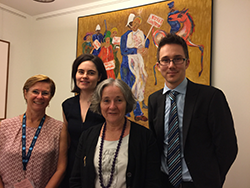
Róisín McMahon
EMCR Forum Executive Member
Researcher at Griffiths University
@roisinmcmahon
In late March I boarded a plane for Canberra armed with a spare phone charger, a cocktail dress and a polished elevator pitch about my research, or in other words, the bare essentials for Science meets Parliament 2017.
Science meets Parliament is an annual meeting of scientists and Federal parliamentarians facilitated by Science & Technology Australia. Now in its 18th year, I was fortunate to be one of 200 scientists descending on the capital to learn how, and why, science and parliament must continue to engage and converse.
Science meets Parliament delivered a thought-provoking, motivating and action-packed two-day program. Australia’s Chief Scientist Dr Alan Finkel set the tone for the event in his opening address on day one, tasking scientists to be effective channels for evidence and advice to politicians. The answer to an uncertain global future, he counselled, is not to build concrete clad shelters in which to hide, but to counter with smart supported solutions: “We don’t need bunkers, we need beakers…[and] beakers need backers and bankers.” Scientists must advocate for their beakers with the right attitude. They must be good ambassadors. They must seek the right access route. They must come armed with the right tools to prosecute their case, mindful that evidence is just one element in typically complex decision-making processes.
Gauntlet thrown, there followed training and discussion on how to talk to the media, policy makers, and of course politicians. Although three distinct groups, each session bore a common lesson. Have a clear, concise message. Consider your audience’s motivations. Don’t just ask for money. Bring solutions, not just problems. We then put this into practice with a series of clever communication games facilitated by Dr Merryn McKinnon and Dr Will Grant. These fun exercises served a serious purpose: professional networking, and preparation for our parliamentarian meeting the next day.
Suitably prepped, I and two other delegates, John Schjenken and Sarah Ellis, met with Senator Claire Moore. Senator Moore, despite being called into the chamber on three occasions, made the time to discuss topics as diverse as reproductive health, antimicrobial resistance, cancer and gender equity in STEM. It was a unique opportunity to have such a wide-ranging dialogue with an elected representative. From there we hurried to the National Press Club to hear the Hon Arthur Sinodinos, Minister for Industry, Innovation and Science, launch Australia’s National Science Statement, before wrapping up with a Parliamentary Friends of Science social mixer at Parliament House.
Science meets Parliament was an extraordinary experience, and one which opened my mind to the importance of scientists proactively engaging with policy and politics. To those scientists who remain wary, Anna-Maria Arabia, Chief Executive of the Australian Academy of Science, advises that “scientists can be politically active without politicising their science.” We shouldn’t be afraid to speak up. There were great professional benefits too. I enjoyed superb networking opportunities, including an EMCR lunch, and it was invigorating to meet scientists across academia, industry and government. I confess it was also slightly surreal to attend a gala dinner in the Great Hall of Parliament House. I really did need that cocktail dress.
Want to join Science Meets Parliament 2018? Apply via your professional and society organisations early next year. In the meantime, catch up on the event via Twitter at #SMP2017 or the @EMCRForum feed.

© 2025 Australian Academy of Science